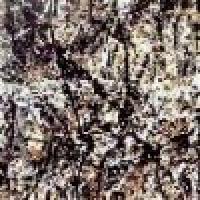
The artist's fractal fingerprint

Photographs of (top) a 0.1m section of snow on the ground, (middle) a 50m section of forest and (bottom) a 2.5m section of Pollock's 'One: Number 31' painted in 1950.
In issues 9 and 11, Plus explored the fractal structures contained in the drip paintings of abstract expressionist Jackson Pollock (see Jackson's fractals and Fractal expressionism). A paper released last month on the physics arXiv reveals that these structures can be used to identify the artist - they serve as Pollock's "fractal fingerprint". Knowing this could not only be useful for art experts trying to tell an original from a forgery, but it also sheds light on why we like looking at some paintings more than others.
In his paintings from the middle of the last century, Pollock used a technique far removed from the traditional brush-in-hand approach. By moving around in a random fashion with as little interference from his conscious mind as possible, Pollock dripped layers of colours onto large canvasses. The resulting images are complex and dense, and very reminiscent of natural patterns - think of the way snow lies on the ground and the way a forest looks viewed from above.
Pollock was not the only artist who engaged in this "gestural expressionism". A group of Canadian artists, called Les Automatistes, which included Marcel Barbeau and Jean-Paul Riopelle, used very similar techniques. But even though the techniques are similar, if you compare a Pollock painting to one by an Automatiste (see the original paper at Multifractal fingerprints in the visual arts), you will find the two to be quite different. What exactly are the features that make this difference? Can they be measured mathematically, and so provide some insight into how our brain perceives patterns - and allow us to tell whether or not a painting is genuine?
To answer this question, a team of North American scientists, J. R. Mureika, G. C. Cupchik and C. C. Dyer, compared eight drip paintings by Pollock with eight paintings by the Automatistes. Scientists had suggested earlier that our brains single out two types of structure when we look at and analyse a pattern. The first structure is formed by the blobs of colour within the pattern - the "blob structure" - and the second consists of those regions in the pattern where the contrast between colours is strongest - the "edge structure". In paintings by the gestural expressionists, both of these structure are fractals: even if you zoom right in on the outline of a splatter of paint, it will still look crinkly and never become a smooth line. This feature - that a small detail is just as complex as the whole - is called "self-similarity" and is the defining characteristic of fractals.
Mureika, Cupchik and Dyer singled out the two types of structures in the different paintings and compared their fractal properties. For each, they calculated the "box counting dimension", a number which measures the overall crinkliness of the fractal (see Plus articles Fractal expressionism and How big is the Milky Way for detailed descriptions of dimension). Although this number gives some idea of the complexity of a fractal, it gives no information on how this complexity varies within the fractal, and so the scientists delved deeper by performing what is called "multi-fractal analysis". This process involves computing the dimensions of the multitude of interwoven structures which live within a given fractal, and gives much more detailed information about how small pieces of the fractal look from close up.
The team's work revealed that the secret seems to lie in the edge structure: Pollock's edges are a lot more crinkly than those of the Automatistes. What's more, the density of the edge structure is very similar to that of the blob structure in Pollock's paintings. This means that the two structures interlock smoothly, forming a coherent, harmonious whole. This might account for the fact that many people have described Pollock's work as calming. By contrast, in the Automatistes' paintings, the two structures are in conflict - the viewer's perception cannot move smoothly from one structure to the other.
Thus, Pollock's paintings, and the pleasure they give to so many people, are indeed characterised by fractal properties. Blob and edge structure play an important role in our perception of patterns, and, when their fractal dimensions are different, our brain is able to distinguish between them - and even see the conflict - at a quick glance. It seems that some undestanding of fractal geometry may be a useful asset to art lovers and forgers alike.